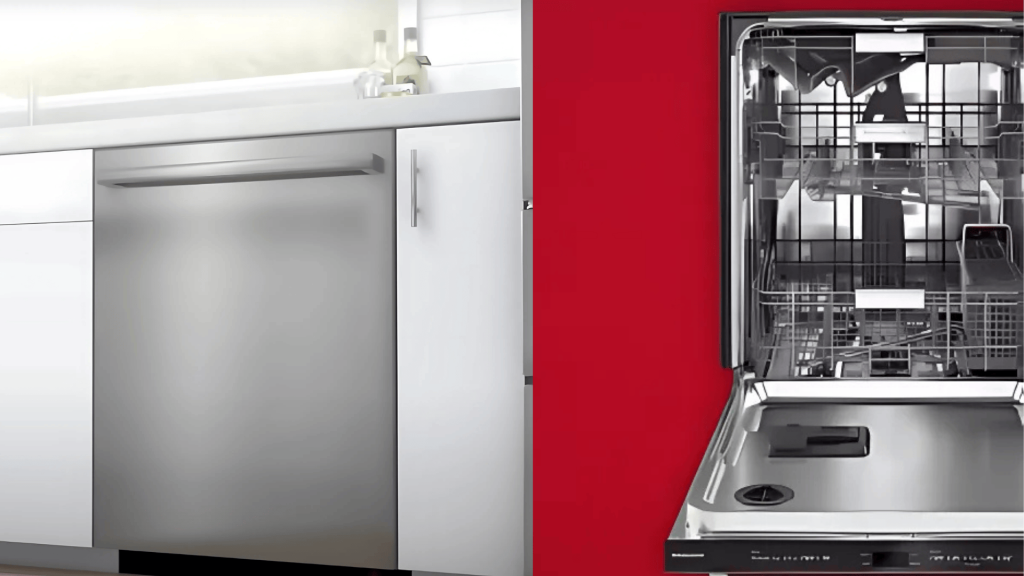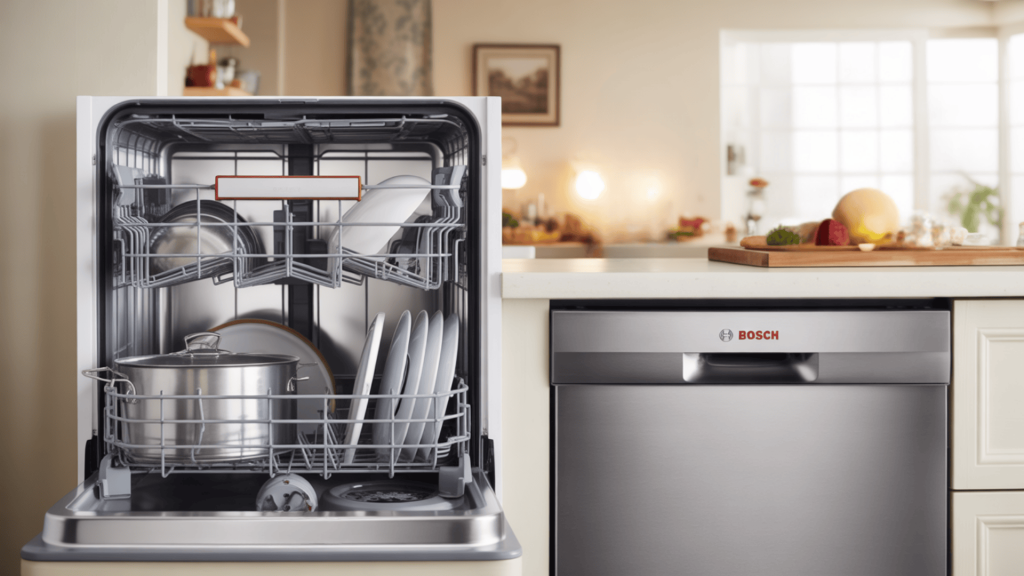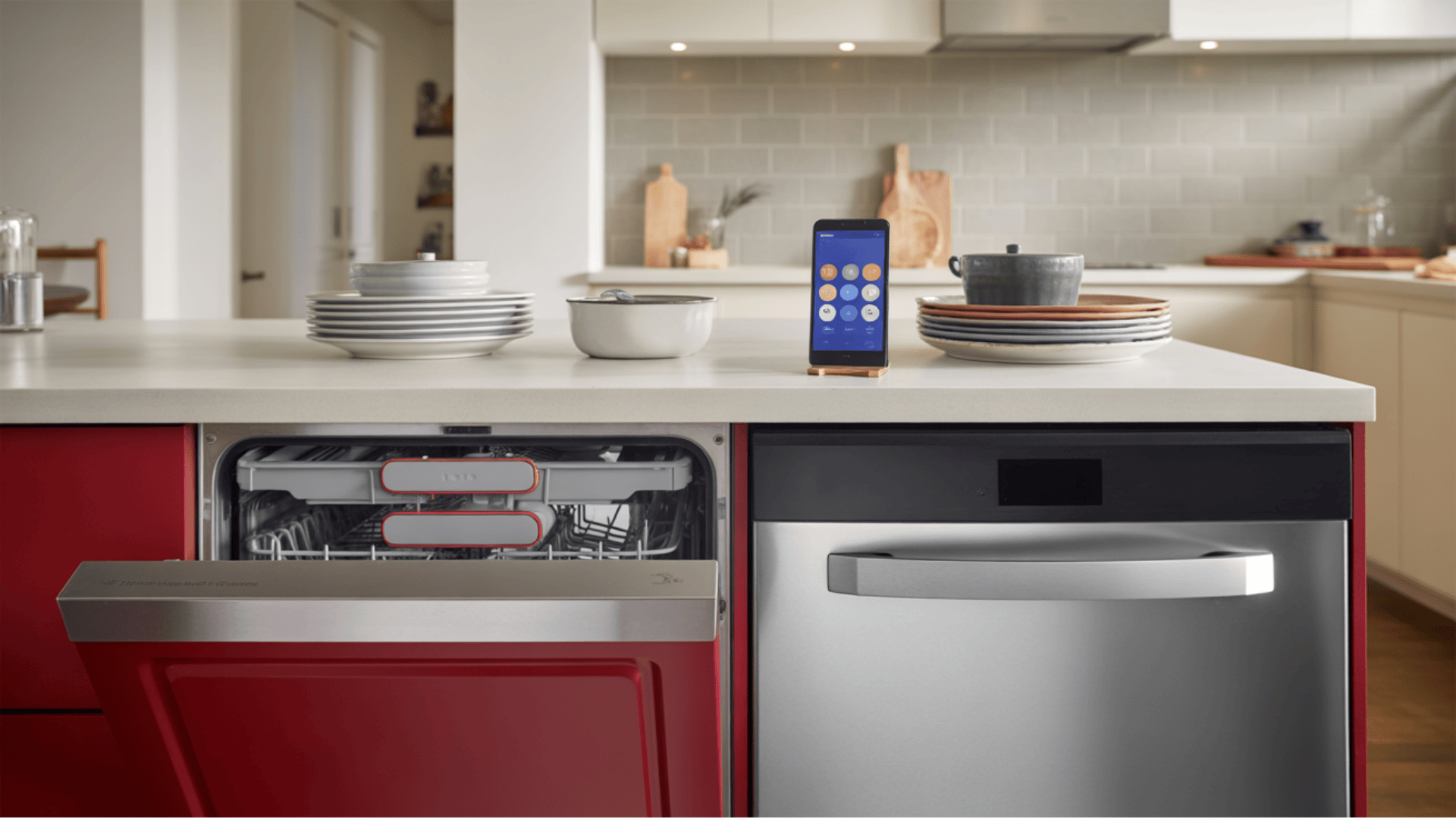When it comes to buying a dishwasher, KitchenAid and Bosch consistently top the lists of most recommended brands.
You’ll find them in countless kitchen showrooms, online reviews, and neighbor recommendations across the country.
But reading manufacturer specs only tells part of the story about how these machines actually perform in real kitchens.
This blog will share with you gathered insights from actual owners, forum discussions, and user reviews to give you the real scoop on both brands.
By the end of this guide, you’ll know which dishwasher fits your specific needs, kitchen setup, and daily routine. Let’s look at what real people are saying about living with these popular dishwashers day after day.
Brand Overview
Understanding what each brand stands for helps explain why people choose one over the other. Here’s what sets KitchenAid and Bosch apart in the dishwasher market.
KitchenAid: Key Features & Reputation
KitchenAid has built its reputation on robust cleaning power that tackles the toughest messes without complaint.
Their dishwashers offer multiple cycle options and consistently responsive customer service when issues arise.
The brand attracts users who prioritize cleaning performance and capacity above everything else. If you regularly cook big meals or have stubborn, burned-on food to deal with, KitchenAid owners say their machines rise to the challenge.
Bosch: Key Features & Reputation
Bosch made its name in dishwashers through exceptionally quiet operation, impressive energy efficiency, and sleek integrated designs that disappear into your kitchen.
Their machines are engineering-focused with innovative features. The brand appeals to users who value reliability, smart drying technology, and water conservation.
Bosch owners often mention the peace of mind that comes with German engineering and the company’s attention to long-term durability.
Featured Products from Both Brands

Looking at specific models helps you understand what each brand offers at different price points. Here are some standout dishwashers that represent each brand’s strengths well.
Popular KitchenAid Models
These models showcase KitchenAid’s focus on cleaning power and flexible loading options across different budgets.
- KitchenAid KDTM404KPS (Mid-Range) This model offers the classic KitchenAid cleaning power with a third rack for cutlery and small items.
- KitchenAid KDTE334GPS (Budget-Friendly) A solid entry-level option that doesn’t skimp on cleaning performance. Features the signature KitchenAid wash arms and heated dry.
- KitchenAid KDTM804KPS (Premium) The top-tier model with advanced features like PrintShield finish that resists fingerprints. Includes dynamic wash arms and premium rack systems.
Popular Bosch Models
These dishwashers highlight Bosch’s reputation for quiet operation, efficiency, and German engineering quality.
- Bosch SHEM63W55N (Mid-Range) One of Bosch’s most popular models combining quiet operation with efficient cleaning. Features the AutoAir drying system and flexible rack design.
- Bosch SHPM65Z55N (Premium) A premium model with extra-quiet operation and advanced features like Home Connect smart technology. The CrystalDry drying system handles plastics better than standard Bosch models.
- Bosch SHP865WD5N (High-End) Top-of-the-line model with benchmark quiet operation and premium materials. Features like the MyWay third rack and FlexSpace tines.
Kitchenaid vs Bosch Dishwasher: What Real Users Say

Real user experiences tell a different story from marketing materials. Here’s what actual owners discuss most often in forums and reviews:
1. Cleaning Performance
KitchenAid dishwashers are consistently praised for handling tough messes, greasy pans, and baked-on food without extensive pre-rinsing.
Users regularly mention being able to load heavily soiled dishes straight from the table.
Bosch models generally provide solid cleaning results, but some users note occasional residue or need for light pre-rinsing on certain models, especially with heavily soiled items.
2. Drying Results
KitchenAid’s heated dry option is appreciated by users for drying plastics and heavy loads. Everything comes out ready to put away, though it uses more energy.
Bosch’s ProDry and AutoAir features are energy-efficient, but some users miss having a traditional heating element when washing plastic containers that tend to hold water.
3. Noise Levels
KitchenAid dishwashers operate quietly, but users consistently note that Bosch is noticeably quieter during operation.
Bosch models are widely regarded as exceptionally quiet – a major selling point for open-plan homes where kitchen noise carries to living areas.
4. Loading Flexibility
KitchenAid’s third racks and adjustable systems are praised for fitting more dishes and accommodating bulky items like stand mixer bowls.
Bosch offers an efficient rack design that works well, but some users prefer KitchenAid’s layout for their specific dishware and cooking habits.
5. Long-Term Reliability
KitchenAid dishwashers show good reliability overall, though some users report diverter leaks after several years of heavy use.
Bosch generally receives higher marks for long-term reliability and fewer repairs. Users appreciate leak sensors and clear error codes that help diagnose issues.
6. Price and Value
KitchenAid dishwashers typically range from $700 to $1,900, with the brand focusing on cleaning power and capacity options across various budgets.
Users often find good value in the mid-range models that deliver strong performance without premium features.
Bosch models span from $500 to $2,300, emphasizing efficiency, durability, and quiet operation.
While generally more expensive at the high end, users frequently debate whether the higher prices are justified by the notably quieter operation and long-term reliability benefits.
Special Features to Consider

Different features matter more depending on your cooking habits and household needs. Here’s how to match the right brand to what you actually care about most.
| Feature | Brand | Notable Technology/Advantage |
|---|---|---|
| Maximum Cleaning Power | KitchenAid | ProWash cycle auto-adjusts pressure/temp, dynamic wash arms reach all corners |
| Quiet Operation | Bosch | Industry-leading quiet technology for ultra-quiet cycles |
| Better Plastic Drying | Bosch | CrystalDry converts moisture into heat, dries plastic thoroughly |
| Smart Home Integration | Bosch | Home Connect app: remote control, alerts, monitoring |
| Maximum Loading Flexibility | KitchenAid | 3rd rack for small items, fully adjustable racks for pots/artifacts |
| Energy Efficiency | Bosch | AutoAir opens the door for steam release, saves energy, and is effective for drying. |
This table highlights where each brand excels so you can quickly match dishwasher features to your specific needs.
Decision Factors: Which Should You Choose?
Think about your typical dish loads first. Heavy pots, pans, and baked-on messes point toward KitchenAid, while mixed loads and quiet operation favor Bosch.
Consider your kitchen layout and how sensitive you are to noise. Open floor plans and dinner entertaining make Bosch’s quiet operation more valuable.
Evaluate your drying needs, especially if you frequently wash plastic containers. KitchenAid’s heated dry might be worth the extra energy cost if you hate towel-drying everything.
Check how each brand’s rack layout works with your actual dishes and cookware. The best design is the one that fits what you want.
Factor in your expectations for long-term reliability and service. Bosch has a slight edge here based on user experiences over time.
Tips from the Community
Real users have learned valuable lessons from their dishwasher purchases that can save you time and money. Here are the most helpful tips shared by experienced owners:
- Visit showrooms when possible – Test rack layouts with your actual dishes to reveal fit issues you can’t see online
- Read recent model-specific reviews – Performance can vary significantly between different models from the same brand
- Consider extended warranties – Major appliance purchases often benefit from additional coverage, especially for higher-end models
- Shop warehouse stores – Retailers like Costco often offer better deals and extended warranties on major appliances
- Measure your space carefully – Check height, width, and door clearance to avoid costly installation surprises
Conclusion
Both KitchenAid and Bosch have strong communities of satisfied users, but each brand excels in different areas that matter to different households.
The right choice depends on matching their strengths to your specific needs and priorities.
KitchenAid wins on cleaning power and capacity flexibility, while Bosch leads on quiet operation and long-term reliability.
Neither choice is wrong, but one will probably fit your lifestyle better than the other.
The key is being honest about what matters most in your daily routine; whether that’s handling tough messes, keeping noise down, or having confidence in long-term performance.
Real user experiences show that both brands deliver on their core promises.
Drop a comment below and share your thoughts; the community insights help everyone make better choices.
Frequently Asked Questions
Which Brand Is Better For Large Families?
KitchenAid generally offers more capacity and flexibility with their rack systems, making them popular with families who run multiple loads daily.
Is The Noise Difference Really That Noticeable?
Yes, users consistently report that Bosch dishwashers are significantly quieter, especially important in open-plan kitchens where sound carries.
Do I Need To Pre-Rinse Dishes With Either Brand?
KitchenAid typically handles food residue better without pre-rinsing, while some Bosch models may need light pre-rinsing for best results.


